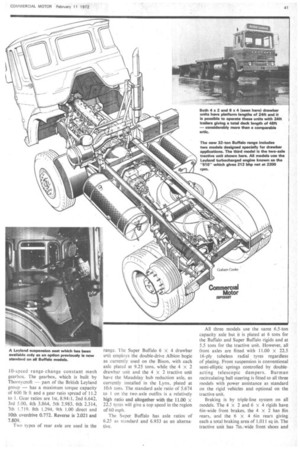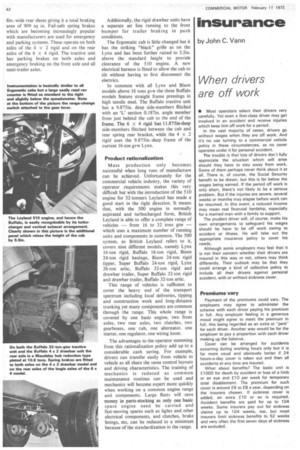Drawbar units in new Leyland
Page 42

Page 43

Page 44

If you've noticed an error in this article please click here to report it so we can fix it.
32 ton
range
by Gibb Grace,
CEng. DAuE. MINIechE
BRITISH LEYLAND truck and bus division has today announced three new 32-ton-gtw vehicles under the Leyland name. These top-weight vehicles comprise a 4 x 2 tractive unit and a 4 X 2 drawbar unit called Buffalo and a 6 X 4 drawbar unit, the Super Buffalo. For the present the existing 28-ton-gtw Lynx and 32-ton-gtw Beaver models will remain but these will undoubtedly be phased out in the near future as Leyland's rationalization policy gets into its stride.
Both drawbar models can, of course, be run solo as normal fourand six-wheelers. Although at the legal weights for these vehicles -16 tons, gvw for the four-wheeler and 22 tons gvw for the six-wheeler — they will be generously powered at 13.25 and 9.65 bhp /ton respectively, this should not deter operators from buying them. Fuel consumption will be a little higher but may be offset by the better performance. The 6 X 4 drawbar unit has a design capacity of 24 tons gvw and can be used at this weight when the latest C and U recommendations are adopted.
Widest choice The new Buffalo range therefore offers the operator the widest possible choice of vehicle configurations at the 32 tons gtw maximum vehicle weight limit.
All three Buffaloes are powered by a turbocharged version of Leyland's 500 series fixed head engine known as the 510. A turbocharged 500 is used in Leyland's National bus but not at such a high power rating. The 510 as fitted to the Buffalo is a small capacity engine, only 8.2 litres, but despite this has a high output, 212 bhp at only 2200 rpm and 578 lb ft torque at 1600 rpm. Both these figures are to latest BS AU 141a : 1971 net installed rating and therefore all the more creditable. With 6.6 bhp /ton available the Buffalo should be a good performer.
All three Buffaloes also use the same 17in. diameter single dry-plate Clutch and
10-speed range-change constant mesh gearbox. The gearbox, which is built by Thornycroft — part of the British Leyland group — has a maximum torque capacity of 600 lb ft and a gear ratio spread of 11.2 to I. Gear ratios are 1st, 8.94:1, 2nd 6.642, 3rd 5.00, 4th 3.864, 5th 2.983. 6th 2.314, 7th 1.719. 8th 1.294, 9th 1.00 direct and
10th overdrive 0.772. Reverse is 2.021 and 7.809.
Two types of rear axle are used in the range. The Super Buffalo 6 x 4 drawbar unit employs the double-drive Albion bogie as currently used on the Bison, with each axle plated at 9.25 tons, while the 4 x 2 drawbar unit and the 4 X 2 tractive unit have the klaudslay hub reduction axle, as currently installed in the Lynx. plated at 10.6 tons. The standard axle ratio of 5.674 to 1 on the two-axle outfits is a relatively high ratio and altogether with the 11.00 X 22.5 tyres will give a top speed in the region of 60 mph.
The Super Buffalo has axle ratios of 6.25 as standard and 6.933 as an alternative.
All three models use the same 6.5-ton capacity axle but it is plated at 6 tons for the Buffalo and Super Buffalo rigids and at 5.5 tons for the tractive unit. However, all front axles are fitted with 11.00 X 22.5 16-ply tubeless radial tyres regardless of plating. Front suspension is conventional semi-elliptic springs controlled by doubleacting telescopic dampers. Burman recirculating ball steering is fitted to all three models with power assistance as standard on the rigid vehicles and optional on the tractive unit.
Braking is by triple-line system on all models. The 4 X 2 and 6 X 4 rigids have 6in-wide front brakes, the 4 X 2 has Sin rears, and the 6 X 4 6in rears giving each a total braking area of 1.011 sq in. The tractive unit has 7in.-wide front shoes and
8in.-wide rear shoes giving it a total braking area of 909 sq in. Fail-safe spring brakes which are becoming increasingly popular with manufacturers are used for emergency and parking systems. These operate on both axles of the 4 x 2 rigid and on the rear axles of the 6 X 4 rigid. The tractive unit has parking brakes on bothaxles and emergency braking on the front axle and all semi-trailer axles. Additionally, the rigid drawbar units have a separate air line running to the front bumper for trailer braking in push conditions.
The Ergomatic cab is little changed but it has the striking "black" grille as on the Lynx and has been further raised to 5.5in. above the standard height to provide clearance of the 510 engine. A new electrical harness is fitted to allow the cab to tilt without having to first disconnect the electrics.
In common with all Lynx and Bison models above 16 tons gvw the three Buffalo models feature straight frame pressings in high tensile steel. The Buffalo tractive unit has a 9.875in. deep side-members flitched with an 'I.,' section 0.187in. angle member from just behind the cab to the end of the frame. The 6 x 4 rigid has 11.875in-deep side-members flitched between the Cab and rear spring rear bracket, while the 4 x 2 rigid uses the 9.875in.-deep frame of the current 16-ton gvw Lynx.
Product rationalization Mass production only becomes successful when long runs of manufacture can be achieved. Unfortunately for the commercial vehicle industry, the variety of operator requirements makes this very difficult but with the introduction of the 510 engine for 32-tonners Leyland has made a good start in the right direction. It means that, with the 500 engine in normally aspirated and turbocharged form, British Leyland is able to offer a complete range of vehicles — from 16 to 32 tons gtw — which uses a maximum number of running units and components in common. The 500 system, as British Leyland refers to it, covers nine different models, namely Lynx 16-ton rigid, Buffalo 16-ton rigid, Bison 24-ton rigid haulage, Bison 24-ton rigid tipper, Super Buffalo 24-ton rigid, Lynx 26-ton attic, Buffalo 32-ton rigid and drawbar trailer, Super Buffalo 32-ton rigid and drawbar trailer, Buffalo 32-ton attic.
This range of vehicles is sufficient to cover the heavy end of the transport spectrum including local deliveries, tipping and construction work and long-distance trunking yet many components are common through the range. This whole range is covered by one basic engine, two front axles, two rear axles, two clutches, two gearboxes, one cab, one alternator, one starter, one regulator, one wiring loom.
The advantages to the operator stemming from this rationalization policy add up to a considerable cash saving. For example, drivers can transfer easily from vehicle to vehicle as all share the same control layouts and driving characteristics. The training of mechanics is reduced as common maintenance routines can be used and mechanics will become expert more quickly when working on a common engine range and components. Large fleets will save money in parts-stocking as only one basic spare engine need be carried and fast-moving spares such as lights and other electrical components, and clutches, brake linings, etc, can be reduced to a minimum because of the standardization in the range.








































































































